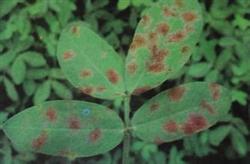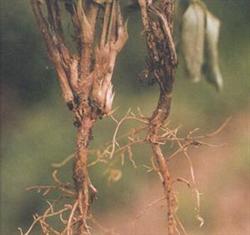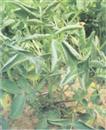Peanuts beware of early defoliation

The main causes of early defoliation of peanut are as follows: the early defoliation and senescence of peanut, and the more serious in the sandy soil; the harm of leaf spot, especially black spot and brown spot, spreads rapidly once it occurs, often causing a large number of leaves to fall off within a few days; early and excessive spraying of regulators is especially more serious than long-term and paclobutrazol and regulators containing this component. Prevention of early defoliation can be aimed at different reasons, take corresponding measures, the main measures are: 1, prevention of leaf spot disease. Peanut leaf spot is mainly caused by black spot and brown spot, and the two diseases are mainly harmful to leaves. During the onset of peanut disease, symptoms began to appear in the lower leaves, and then gradually spread to the upper leaves, producing brown spots in the early stage of the disease, and gradually developed into round or irregular disease spots. The spot of brown spot is larger, there is a yellow halo around the spot, while the spot of black spot is smaller, the color is lighter than brown spot, the edge is neat, and there is no obvious halo. The weather is humid or long-term overcast and rainy, disease spots can be combined with each other into irregular spots, leaves scorched, seriously affecting photosynthesis. If it occurs on the petiole, stem or fruit needle, it will produce oval black-brown or brown disease spots, and if it is heavy, the whole stem or fruit needle will blacken and die, resulting in a great decrease in peanut yield. In the late growth stage of peanut, there are many kinds of leaf spot disease that harm leaves and cause early defoliation, and brown spot disease and net spot disease are the most serious and difficult to control. In the early stage of the disease, 80% mancozeb or Dasheng 600 × 800 times can be sprayed 3 times every 8 to 10 days, or 70% methyl topiramate 800 times 1000 times or other new fungicides can be sprayed. 2. Foliar spraying fertilizer. In the late growth stage of peanut, the ability of roots to absorb nutrients from soil and the ability of nodules to fix nitrogen began to decrease, while the ability of leaves to absorb nutrients was enhanced. Foliar fertilizer supplementation has many advantages, such as fast absorption, rapid action, high utilization rate, good return and so on. It is a better measure to prevent premature senility caused by early defoliation. Foliar topdressing is a fertilization method often used in production. This paper introduces the fertilizer suitable for foliar topdressing of peanut and its application method: 1% urea solution can be used for foliar spraying. Peanut leaves have a strong ability to absorb phosphorus. In the middle and later stages of its growth, 60kg was sprayed once every 7-10 days with 2%-3% superphosphate extract every 667 square meters, which could accelerate the transport of photosynthate to pods. Potassium dihydrogen phosphate. Use 150g potassium dihydrogen phosphate 200g per 667m2, spray water 50kg in the evening or cloudy afternoon after being fully dissolved, preferably three times at an interval of 7 days; if it rains within 8 hours after spraying, re-spray it once, which can increase production by 18.2% to 26.9%. The application of iron fertilizer to iron deficient soil can increase the yield by more than 10%. Generally, 0.2% ferrous sulfate solution is sprayed once every 5-6 days for 2 times in a row during the flowering stage, podding stage or iron deficiency symptoms of peanut plants.
- Prev

Occurrence and Control techniques of Peanut Stem Rot
In recent years, the planting area of peanuts in our region has increased year by year, and peanut diseases have increased year by year, especially the harm of peanut stem rot has increased rapidly. According to the investigation and statistics, from 2001 to 2003, the incidence of the disease accounted for 89.6%, the rate of mild diseased plants was 10-20%, serious ones could reach more than 60%, and even died in pieces without harvest. ...
- Next

There are spots on the bottom leaves of peanuts. What's wrong with the curl of the upper leaves?
According to the preliminary diagnosis of mixed scab caused by leaf spot disease, it is recommended to spray carbendazim, methyl topiramate, Ami Miao, Shigao, Dakening, Amisida and so on. It is best to use the two agents alternately, once every 5 to 7 days, and 2 times in a row. At the same time, potassium dihydrogen phosphate was sprayed on the leaves.
Related
- The first cup of black tea in spring, the flavor and history of tea gardens in Kenya, Africa
- The computer can not only choose potatoes, but also grow tea rice. AI will grow winter oolong tea champion.
- It is not only the inflated tea bitten by insects, but also engraved with the four seasons tea in Beipu.
- The Oriental Beauty Tea Festival in Zhuxian County takes the stage at the weekend to experience the plus-size feast of oil tea.
- & quot; Oriental Beauty Tea & Exploration of Emei in Hsinchu, the hometown of quot;
- The new variety of strawberry "Tainong 1" dessert is the first choice with mellow aroma. Crimson gorgeous
- History of Tea in Taiwan: from Wild Inner Mountain to Export Tea Garden
- Two types of Taiwan Oriental Beauty Black Tea won the British three-Star Award for Childhood Tea Xiang Zhang Jiaqi changed from pilot to champion tea maker.
- Banana species and varieties: the planting history of Taiwan Xianren banana and dwarf banana is long, is banana disease resistant?
- Coffee planting Technology: Qianjie Coffee from Seedling to harvesting

